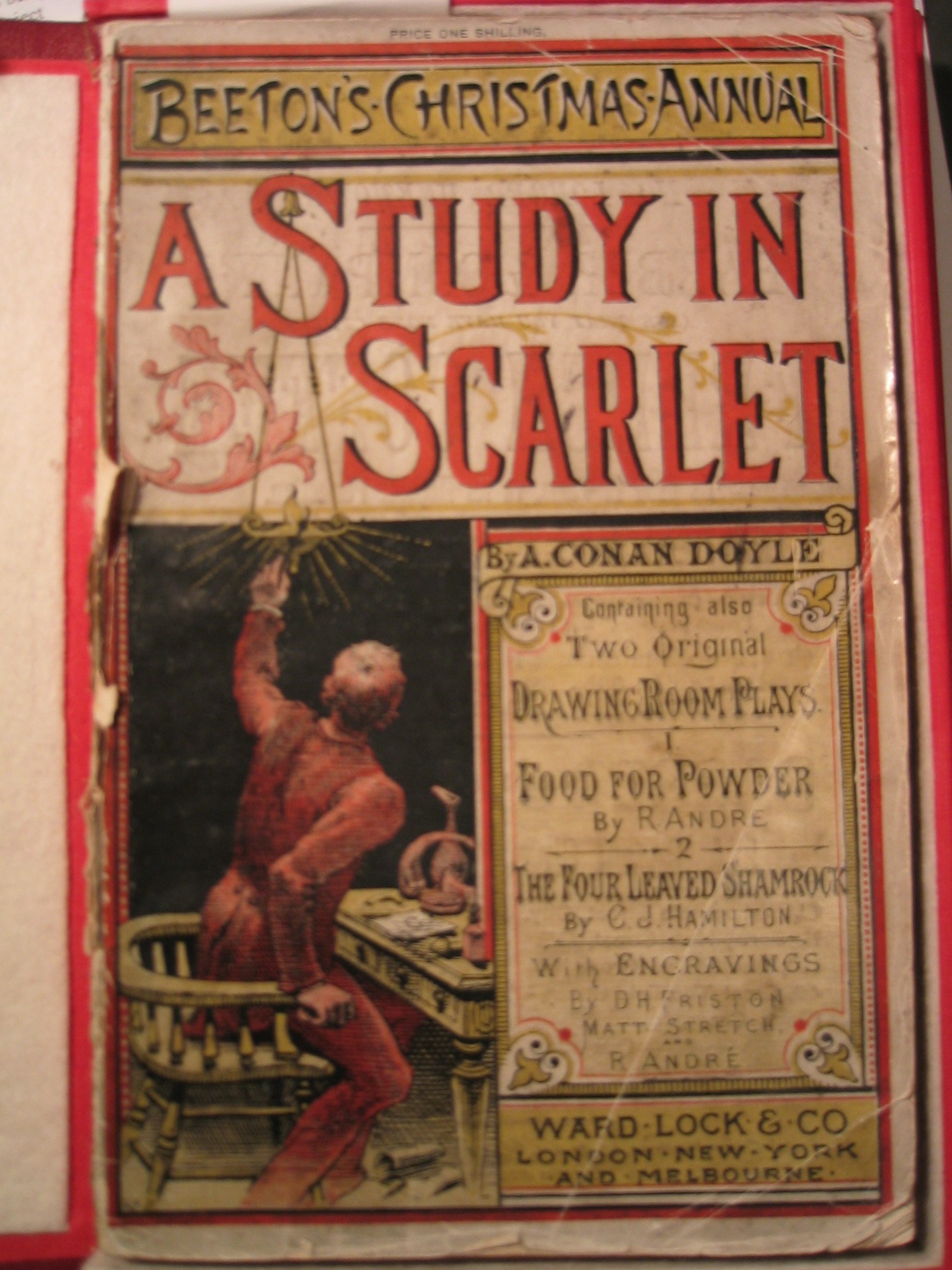There's one little problem, I don't know the date the darn thing rolled off the presses. It wouldn't really matter much except for the fact that the Annual contained the first appearance Sherlock Holmes.
It appears that the Annual was printed in November but we don't have the date and we've run the 'anniversary' as late as December 15.
Here's that 2007 post with a couple additions:
Another Anniversary Already? And How Much is it Going to Cost?

It was
Here's the most expensive magazine in the world:
Sotheby's held the sale in New York City on 21 June 2007.
The owner, a lady, put up two Sherlockian lots for sale."
Lot 105, Beeton's Christmas Annual for 1887, set a new auction record for that magazine and sold for $156,000. The hammer price was $130,000 and the 20% buyer's premium brought the total to $156,000. That beat the previous record of $153,600 set in an auction at Sotheby's in December 2004. The 2004 record was said to make Beeton's the most expensive magazine in the world, and this new sale reinforces that position.
I can't imagine there is any one site in the world with more information on "The World's Most Expensive Magazine".
In 2011 he reported on a previously unknown copy that was offered at auction in Australia but failed to reach the reserve.
Maybe in the next equity bull market.
And from Forbes a picture of the madness that can overtake persons of any station:
A Former Apple Executive's Obsessive Search For Sherlock Holmes
“I like artifacts,” says Glen Miranker. “I get an emotional and visceral and intellectual connection with a subject I’m interested in through them.” For the 60-year-old former chief technology officer for Apple that abiding subject is Sherlock Holmes, the legendary detective created by Sir Arthur Conan Doyle in 1887. The evidence? An extraordinary collection of books, manuscripts, illustrations and ephemera (known as “Sherlockiana”) that he began building in the 1970s, which now includes approximately 4,500 items and fills three rooms in his San Francisco home.The other site most noted by the cognoscenti:
Miranker’s interest in Holmes began when he first read Conan Doyle’s mystery stories as a child. Later, as an undergraduate at Yale, he rediscovered Holmes when a roommate dropped a copy of the complete stories into his lap to cheer him up during a night of melancholy–”Maybe I was turned down for a date or thought I blew a test,” says Miranker.
The collecting started a bit later, in 1976 or ’77–he can’t quite recall–when he was in graduate school for computer science at MIT. His wife, Cathy, went out on a walk, ducked into a little book fair at Harvard’s Gutman Library and, for $15, picked up a copy of the first American edition of The Case-Book of Sherlock Holmes. Miranker says the choice of that volume was driven primarily by a simple motive: “To be brutally honest, of the books that might have been of interest to me, this one was the most affordable.” But something clicked when she handed it to him. “I remember thinking, ‘You mean you don’t have to be J.P. Morgan to collect books?’” Today, that book–the seed of his collection–rests in a special box made by Cathy, on which she playfully embossed: “World’s Costliest Book.”
Miranker started collecting slowly, picking up rare and fragile editions of Conan Doyle’s books as he worked his way through the tech industry (with stops at Ardent Computer and NeXT Computer) and adjunct professorships at Columbia University and UC Berkeley. Ten years after getting that first Holmes book, Miranker’s grouping hit a critical mass, turning into a full-blown collection. The tipping point came around 1985, when he acquired the book collection of Marvin Epstein, a mathematician at Bell Labs in New Jersey and a prominent figure in the Sherlockian community.
“Marv had a secret weapon,” says Miranker. “From the ’60s through the early ’80s, he had a WATS line, which he burned up hunting down Sherlockian books.” Miranker counts Epstein, who was “unbelievably generous with his time and knowledge,” as one of his three gurus in Sherlockiana. The other two are Dan Posnansky, “a remarkably talented collector” who lives in Kennebunkport, Maine, and Peter Stern, an antiquarian book dealer in Boston and the world’s foremost dealer in Holmes material (among other specialties), who has supplied Miranker with a sizable portion of his collection.
Miranker’s passion for Holmes continued when he joined Apple in 1996 to help launch the iMac, eventually becoming the chief technology officer until he retired in 2004. Today, he sits on the boards of various organizations, including the Toronto Reference Library and the National Cryptologic Museum. (Cryptology is another passion of Miranker’s, which extends into collecting–he owns two Enigma machines, devices used by the Germans in World War II to encode messages.)
Aside from rare first editions with mint dust jackets, Miranker has collected autographed copies with special association value, original manuscripts and so-called pirated editions–books published in violation of copyright, without paying the author, which often happened to Conan Doyle due to the popularity of his books and the lax enforcement of the day. Miranker points out that some of this material first appeared in book form in these editions (most of the stories originally ran in the London-based Strand Magazine), such as the first American printing of The Sign of Four, published by Collier in 1891, which can be worth more than $10,000. He particularly treasures another pirated edition of this book, issued by the United States Book Company and signed by Conan Doyle himself–despite the theft of his intellectual property–to a Chicago department store magnate, Harlow N. Higinbotham (estimated worth: $50,000-$75,000). While Miranker generally stays away from translations, he is quite pleased with his Yiddish edition of The Sign of Four, published in Brooklyn in 1930....MORE
Always 1895